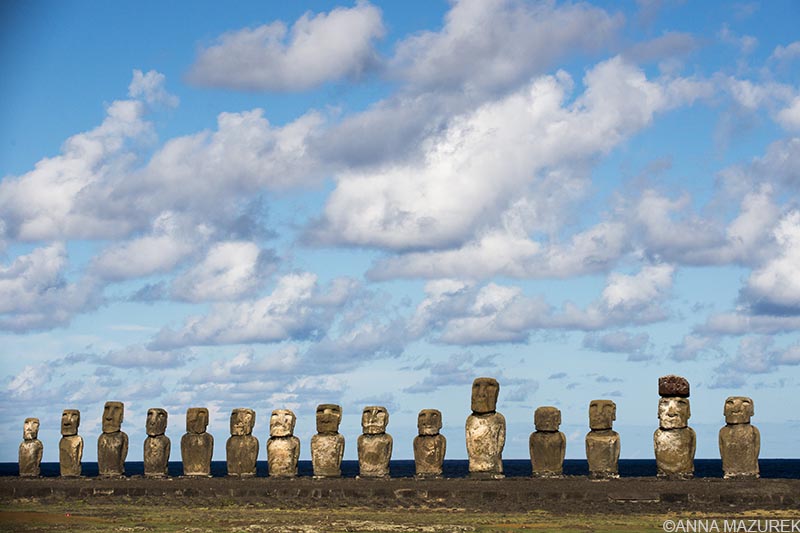
Ahu Tongaraki is normally a popular sunset spot on Easter Island, but I prefer to photograph it in the late afternoon when the light highlights the detail in the moai statues.
This day could not be more perfect— blues skies, windows down and Jack Johnson on the radio.
The view is stunning—steep cliffs lined with moai statues hover over the Pacific Ocean. I slow the car down to let the wild horses cross the road. The tiny island is one of the most remote and unique places on the planet. It lies in the middle of the Pacific 2,290 miles from mainland Chile; the nearest inhabited island is 1,150 miles away. It’s only 14 miles wide and with an extinct volcano at each end of the island.
The history of Easter Island, known as Rapi Nui to the natives, is turbulent. Polynesians first discovered the island between the 4th and 8th century. They built the famous towering moai statues on top of stone platforms called ahu. Tribal wars irrupted over land, and statues were toppled. A lack of resources from slash and burn agriculture techniques among other factors led to massive deforestation, which is still present today. The Dutch arrived on Easter day in 1722 and named it Easter Island, which is called Isla de Pascua in Spanish.
The island’s airport is the most remote in the world and has a fascinating history. It was built by the U.S. Air Force in 1966, which opened the island to tourism. The runway was later widened by NASA as an abort site for the space shuttle allowing larger jets to land.
Rising seas, erosion and climate change are a major threat to the tiny island and make it important than ever to visit NOW. Check out my detailed photo guide to the top sites including photography tips, logistics, costs and budget tips! This was one of my favorite parts of my four-month South America trip!
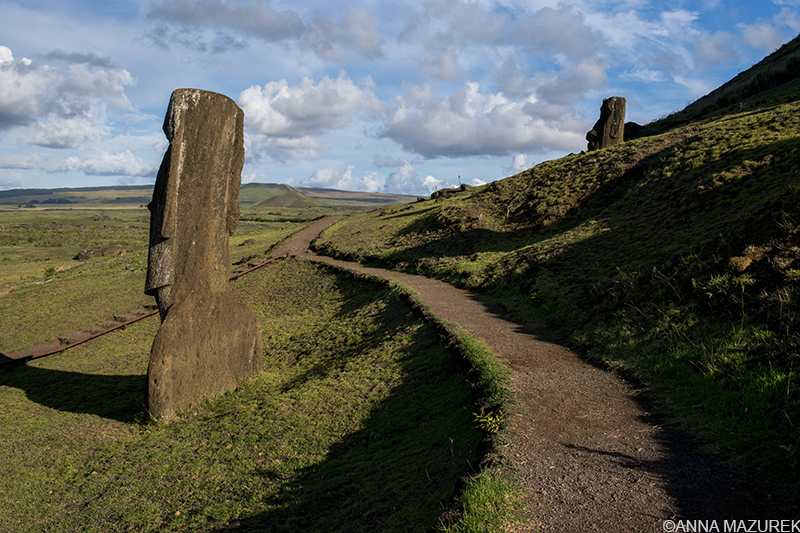
A series of trails wind through Rano Ranaku, the quarry where all the statues were made.
History of the Moai Statues
Easter Island is famous for all the moai statues—gigantic carved figures made of volcanic rock lined up on platforms called ahus. The statues represent the ancestors of the Rapi Nui people and once overlooked a village site. Some statues have hats or topknots called pukao that resemble the hairstyle of the natives. All of the moai that are standing have been restored.
For a good history lesson, watch the NOVA PBS documentary on Easter Island before you go. It’s available on PBS and YouTube.
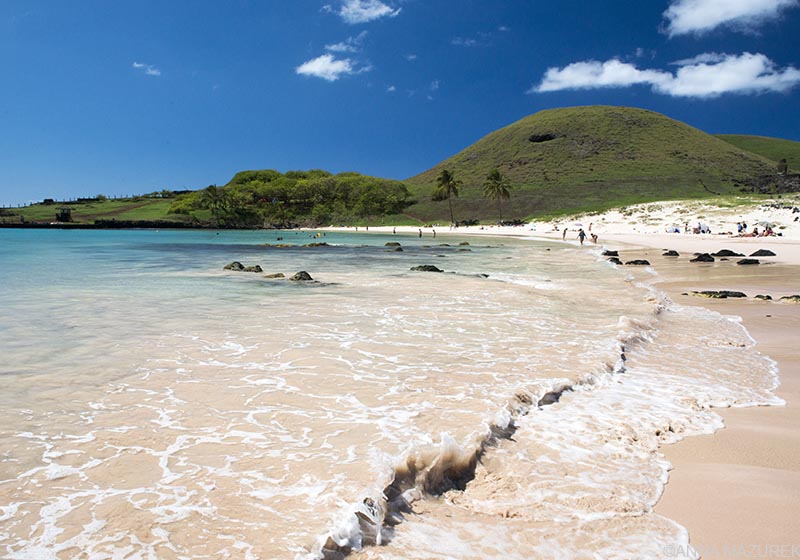
Anakana was the sight of the first settlement on Easter Island, known as Rapi Nui to the native people. It’s the only white sand beach on the volcanic island.
National Park Tickets
The majority of the sites on Easter Island are part of Rapa Nui National Park. A ticket is required at every major site. Tickets are $80 or 54,000 Chilean pesos and available at the airport. Check the current exchange rate to see which is best. I saved $9 buy paying in USD. Tickets are valid for 10 days. You can only visit Ranu Raraku and Orongo Ceremonial Village once per ticket. The other sites allow multiple entries. You can pay by credit card but only in pesos. No drones are allowed on the island.
Park Hours
Rano Raraku, Orongo, Anakena, Tahai, Ahu Akivi
Monday & Wednesday 9:30 a.m. – 8 p.m.; Other days 9 a.m. – 8 p.m.
All other sites close at 6 p.m. and open at the same time above. Several of the sites are still visible from the road for photography outside these hours.
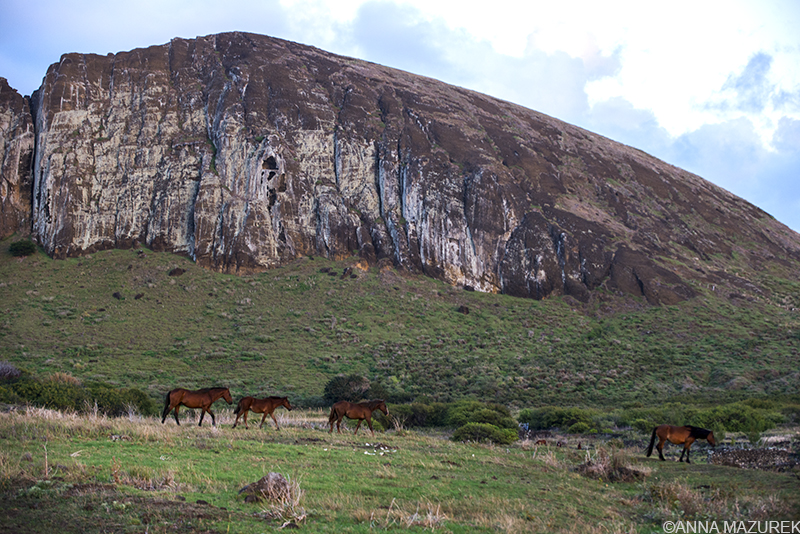
Wild horse roam at the base of the Rano Raraku volcanic crater.
Top Sites On Easter Island
Hanga Roa
This is the only town on the island and it’s where all the accommodation, restaurants and nightlife are clustered. It’s also home to the anthropology museum, Museo Antropológico Sebastian Englert, which is the best place to start your trip to get an introduction to the culture and history. Admission is free.
Most tourism agencies, rental car centers and grocery stores are located along Avenue Atamu Tekena. There’s two banks in town with currency exchange ange ATMs. (Banco Estadio & Banco Santander). We used the Santander ATMs and had no issues with our Visa debit cards.
There’s a small swimming area in the town called Playa Pea. There’s no proper beach, but it’s a good place to cool off. There are a few restored moai scattered around the edges of town but are not as grand as others on the island.
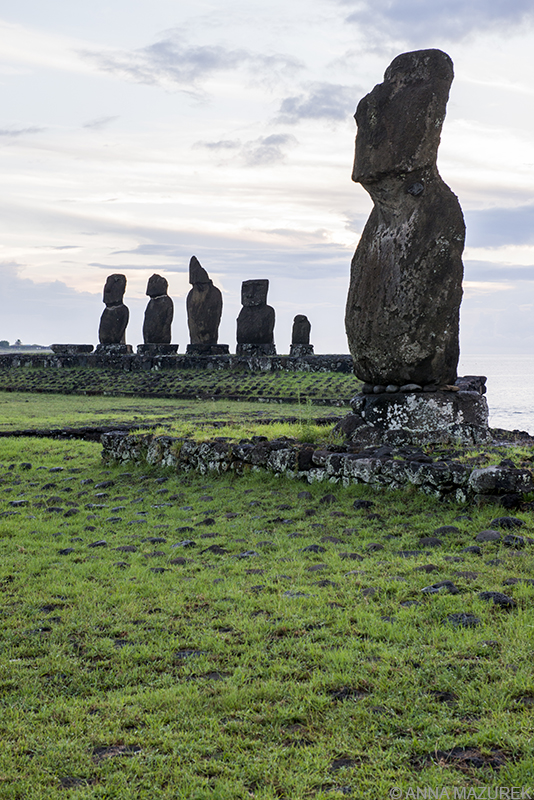
Ahu Akapu with Ahu Tahai in background. Both sites are walking distance from Hanga Roa.
Ahu Tahai & Ahu Akapu
On the coast north of Hanga Roa is Ahu Tahai, which supports five moai. There’s a lone moai with eyes on the adjacent cliff, Ahu Akapu. It’s a very popular sunset spot and an easy walk from town.
Best time for photography: Sunset for a silhouette photo or early morning when the light highlights the details in the statues.
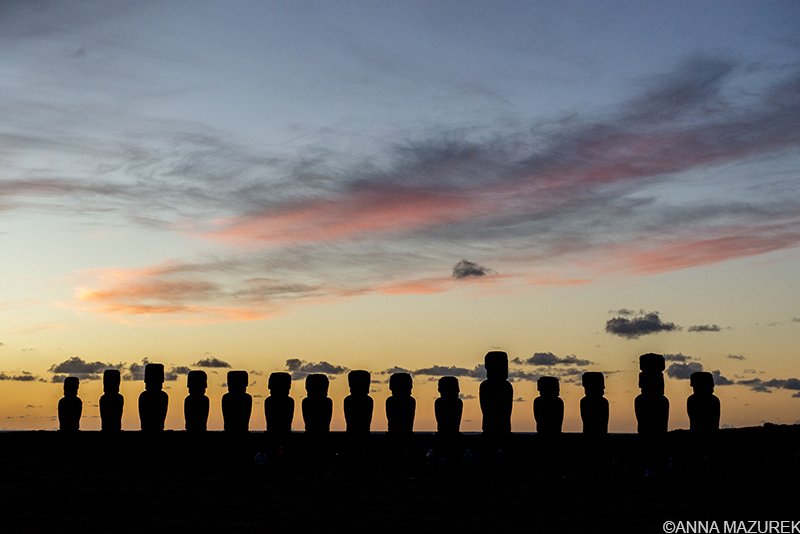
The gates at Ahu Tongariki opened just before sunrise, and there was a crowd of about 25 people waiting. The site is huge so it didn’t feel overcrowded when I visited in March. Crowds might be more of an issue in the peak season (Dec. to Feb.).
Ahu Tongariki
The most popular sunrise spot is Ahu Tongariki, the largest ahu on the island with 15 statues. The scenery behind the 15 statues is breathtaking – the towering cliffs of Peninsula Poike. The sunrises directly behind the statues providing the famous silhouette photo. The moai have their backs to the water and face the ruins of an old village site. There are some petroglyphs near the far end of the site by the road. I personally prefer going back here late in the afternoon when the details of the moai really stand out.
Best time for photography: Late afternoon or sunrise (silhouettes only)
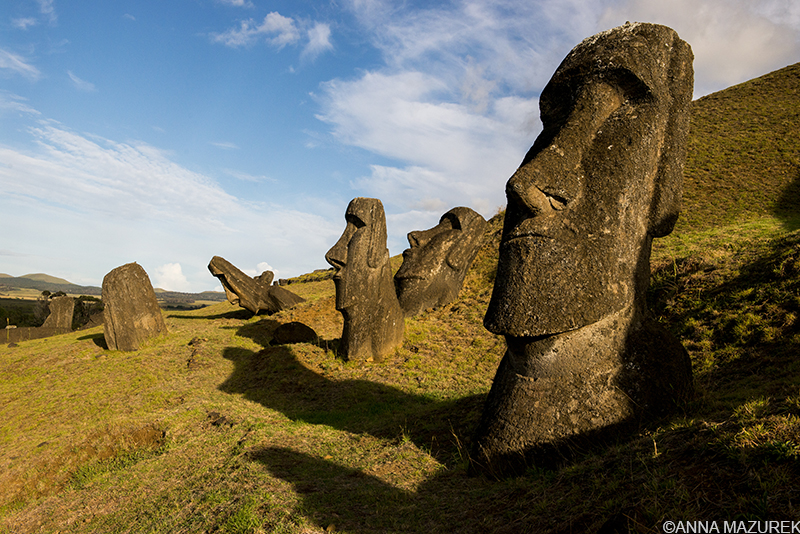
Rano Ranaku is best photographed early in the morning or late in the afternoon to get the details in the statues. This was shot right after the site opened in the morning.
Rano Raraku
All of the moai on the island came from the quarry of Rano Raraku, known as the “nursery.” The sides of the gigantic volcanic crater are covered with moai in various stages of construction. It’s also home to a unique kneeling moai on the southeastern side.
Best time for photography: For good side light, late afternoon or morning is best. The only trouble is keeping people out of the frame. Keep your fingers crossed for a cloudy day!
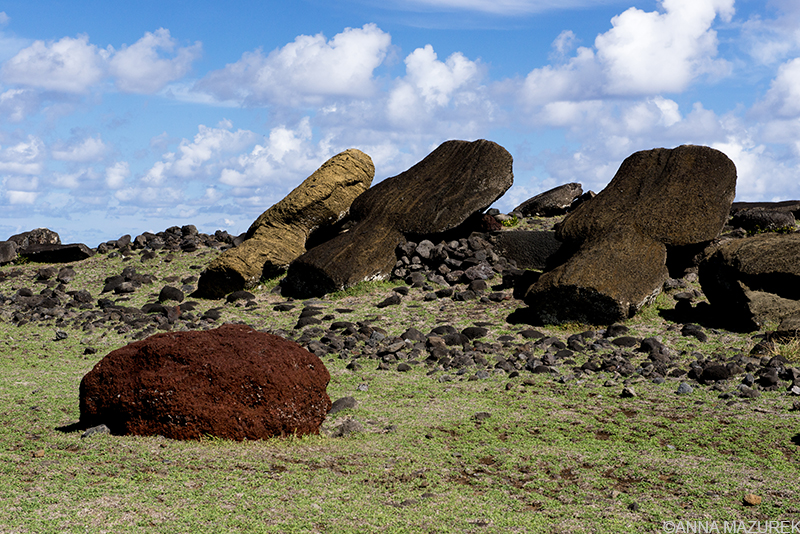
Ahu Vaihu is one of many sites on the island that hasn’t been restored. All of the standing moan statues were restored starting in the 1960s.
Ahu Vaihu & Additional Sites on Southern Coast
Along the road to Ahu Tongariki, there’s several platforms with broken moai laying facedown. At Ahu Vinapu, one of the platforms has mortar-less blocks similar to the Inca ruins in Peru.
Best time for Photography: Late afternoon when the sun is shining on the statues.
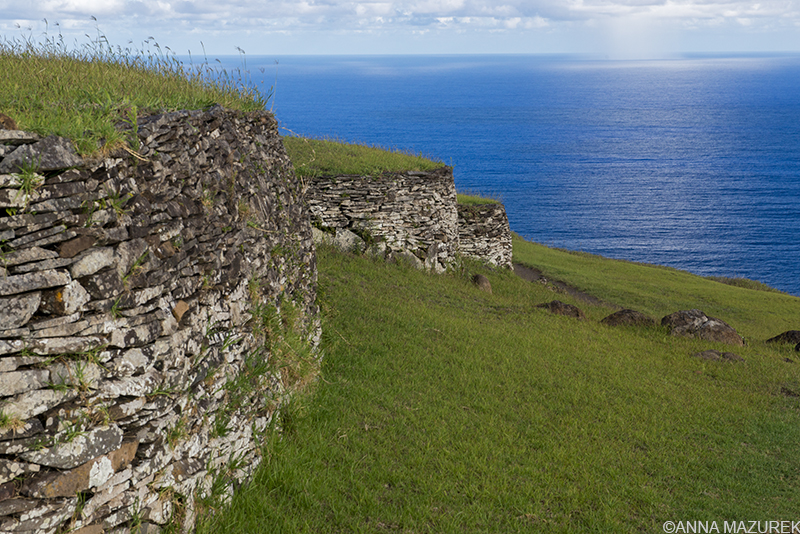
Orongo Ceremonial Village lies on the edge of an extinct volcano on Easter Island.
Ranu Kau & Orongo Ceremonial Village
Stunning the best word to describe Orongo Ceremonial Village. It’s perched on the top edge of a crater lake called Ranu Kau and a cliff above the ocean. The walls of the short houses are made of stacks of thin stone slabs and offer views of small offshore islands. The village was the epicenter for an island-wide bird cult during the 18th and 19th centuries and features bird petroglyphs.
Orongo can be reached by car and is 4 kilometers from town. There’s also a short, direct hike from Hang Roa. There’s a viewpoint of the crater that’s accessible before you reach the village that doesn’t require a ticket.
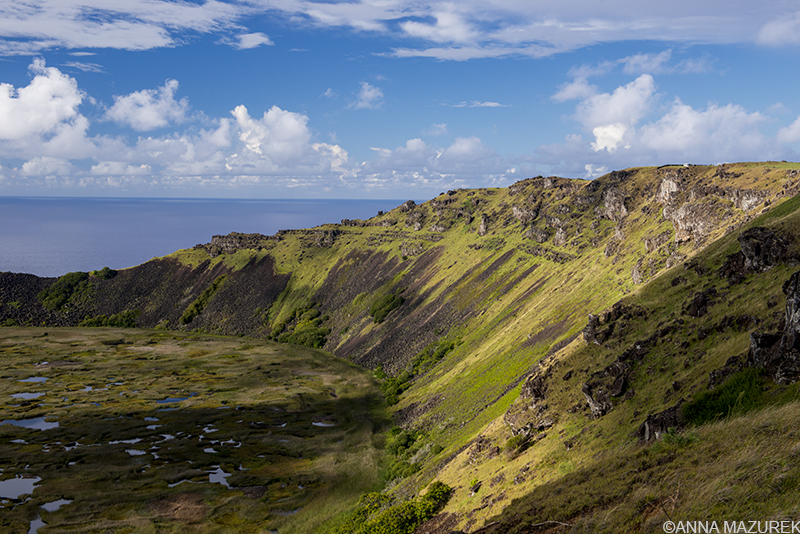
The Ranu Kau crater is best photographed when the light is overhead. If you go too early or late in the day, there will be shadows along the edges like this photo which was taken early in the morning.
Best time for photography: The village faces west so afternoon or sunset light is best. The site is fairly empty by 6 p.m. The crater is best photographed in the afternoon or midday when the sun shines into the carter. If you wait too late, you’ll have dark shadows on the western side and center of the crater.
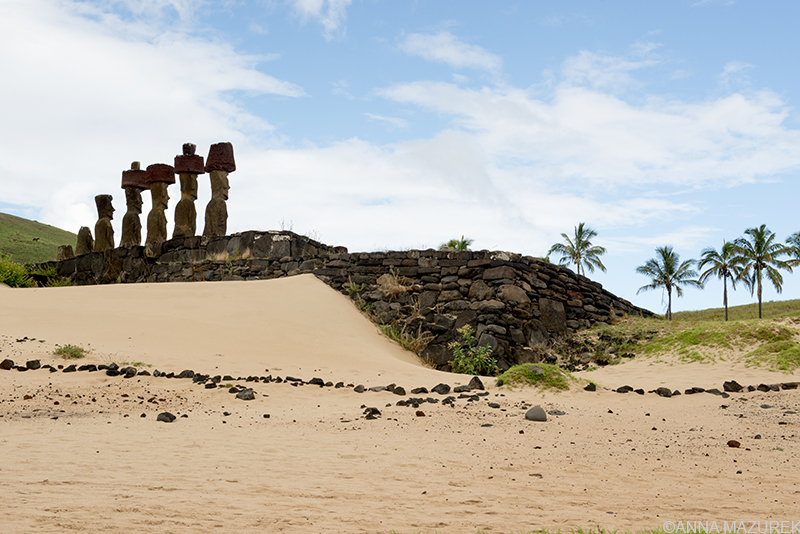
Ahu Nau Nau is the star attraction of Anakena beach. The platform is home to seven moai statues.
Anakena
Anakena is the most photogenic spot on the island and the site of the first settlement. The white-sand beach is lined by palm trees that surround the main attraction – an ahu of seven moai with topknots known as Ahu Nau Nau. This set of moai statues has more topknots than any other restored ahu on the island. There’s another lone moai, Ahu Ature Huki, to the right. A handful of over-priced restaurants and bars line the eastern side of the beach. The crystal-clear waters are a great refuge from the heat.
Best time for photography: Afternoon or sunset. Since the moai face away from the ocean, you need to afternoon light to get good detail in faces of the statues.
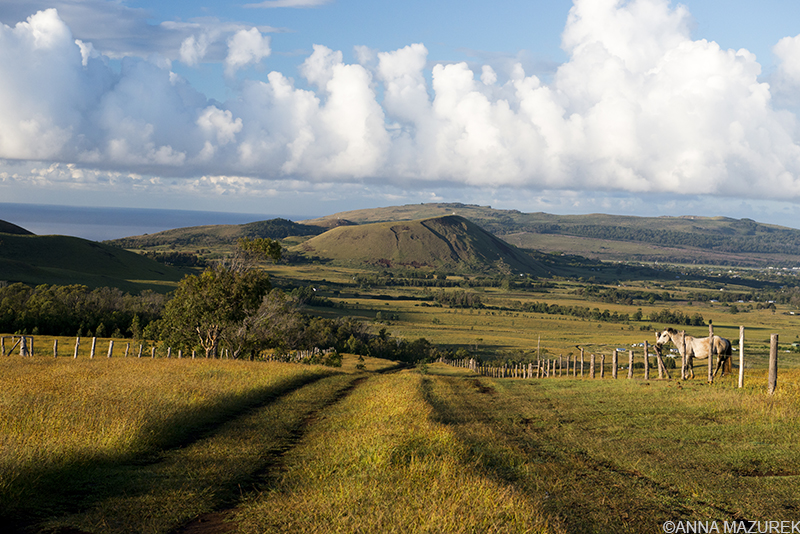
The trail to Maunga Terevaka, the island’s highest point, is gorgeous and very easy.
Maunga Terevaka
Climbing to the top of Maunga Terevaka is the only way to really grasp the small size of the island. It is one of the three extinct volcanos and the tallest point on the island. From the top, you can see the ocean on all sides of the island. It’s accessible by foot or horseback. It’s a very easy walk, and the trail is obvious. Go at sunrise when it’s cool, and you’ll have the place to yourself. It took us a little more than an hour to climb stopping a lot for photos. The scenery on the way to the top is just as amazing as the view.
Best time for photography: Sunrise
Puna Pau
This volcanic quarry is the source of the red cylinder topknots that adorn the statues called pukao, which are thought to resemble the hairstyle worn by the native tribes. Over sixty pukaos were transported around the island and another 25 lie near or at the quarry.
Best time for photography: Late afternoon or early morning to get detail in the pukaos.
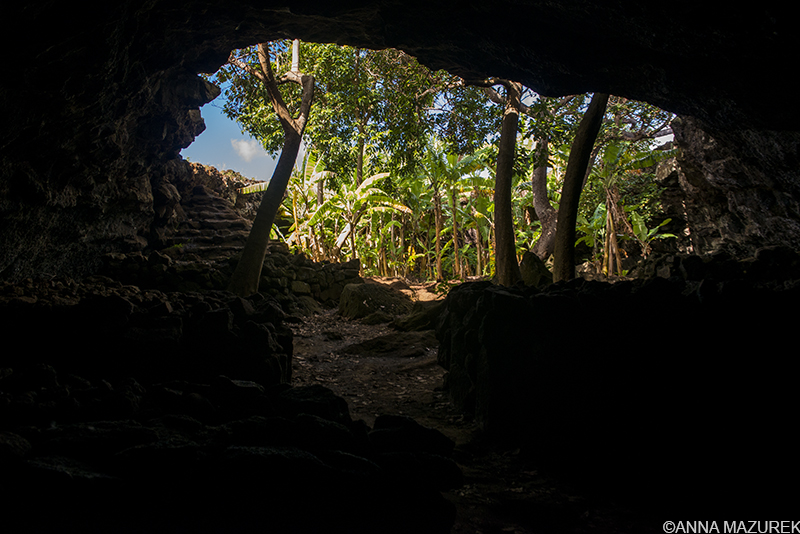
Ana Te Pahu Cave is the largest cave on the island.
Ahu Akivi & Ana Te Pahu Cave
These are the only moai that face the ocean, and the only ones not located along the coast. The seven moai on this ahu were restored in 1960 and have an astrological meaning. During the equinoxes, the statues directly face the setting sun. The trail to Maunga Terevaka starts at the edge of the parking lot.
If you turn left at the entrance to Ahu Akivi, there’s a road that leads to the entrance booth for Ana Te Pahu Cave. You must walk 15 minutes to the cave itself. It’s totally walkable from the parking lot of Ahu Akivi as well. It’s the largest cave on the island and over 7 kilometers long and overgrown with bananas and sweet potatoes.
Best time for photography: Late afternoon light shines directly on the statues and highlights the detail. I was always here in the mornings, and the light was pretty horrible.
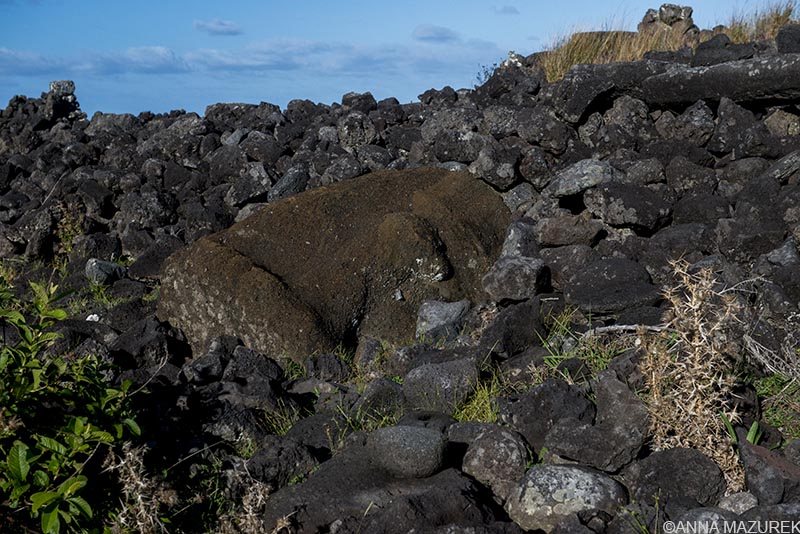
The face of a moai statue lies on the ground on the rugged Northern Coast of Rapi Nui. The northern portion of the island has no roads and is very isolated.
North Coast
Hiking the Northern Coast is the best way to experience the REAL Easter Island. There are no roads leading to this section and none of the moai or sites have been restored. You pass several toppled moai, extensive amount of petroglyphs, stone houses and a few caves. Keep an eye out for the lone standing moai that’s hidden in one of ahus. The hike is fairly easy and takes roughly five to six hours. It starts near the Ana Te Pahu cave and ends at Anakena.
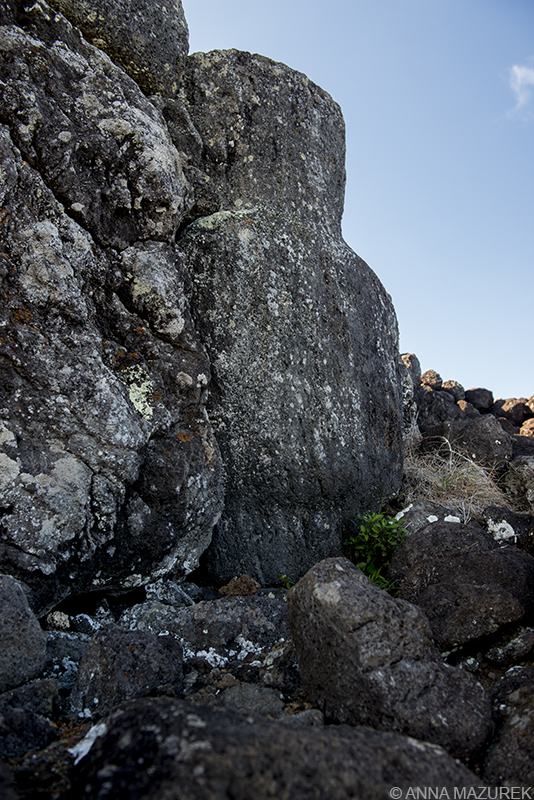
This moai statue on the Northern coast was lowered and hidden as part of the platform to prevent it from being toppled during tribal wars.
A guide is recommended since none of the locations are marked by signs, and there’s no real trail. Tour companies offer half-day hiking trips for around $200/person. Ask around for a local guide for a cheaper rate, which is how we got a guide for $80/person.
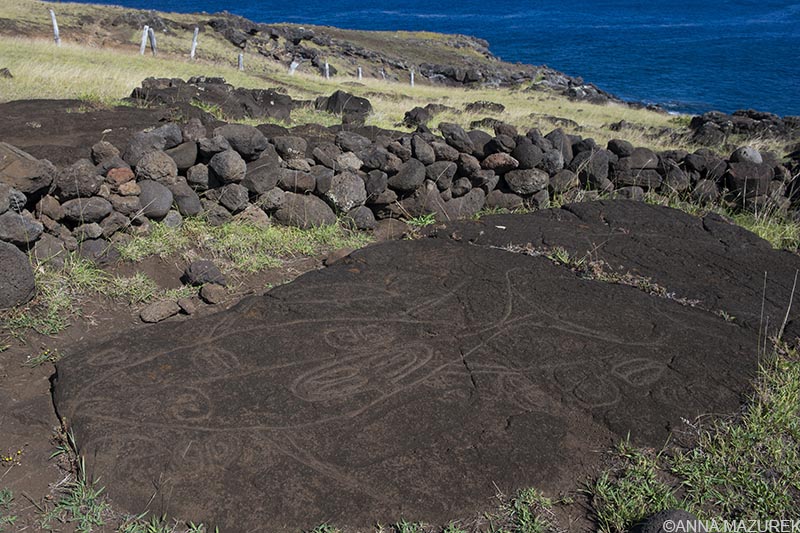
Petroglyphs are scattered all over the island. The best ones are along the untouched northern coast like this one above.
Papa Vaka Petroglyphs
These petroglyphs are located between Anakena and Ahu Tongariki. They are the easiest ones to reach but not as good as the ones along the remote Northern coast.
This isn’t a complete list of sites because there were a few sites we didn’t make it to because of weather. These are the best ones for photography.
Easter Island Logistics:
Costs, Transport & Accommodation
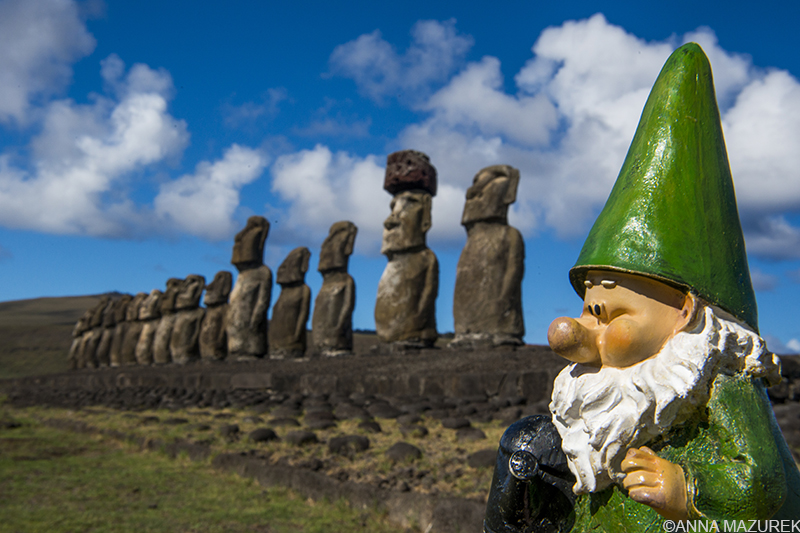
Alfred the gnome believes this shot of him at Ahu Tongariki is one of his best travel photos to date.
Best Time to Visit Easter Island
It’s a great location year-round except for April when it rainfall is the highest. Summer (December to February) is the busiest season especially around the annual Tapati Rapi Nui Festival in February. Temperatures hover in the low 80s F and don’t usually drop below 60 in the winter months. Driest months are October for February. I went in late March to avoid the crowds and get the best weather. It rained a few times, but it was brief.
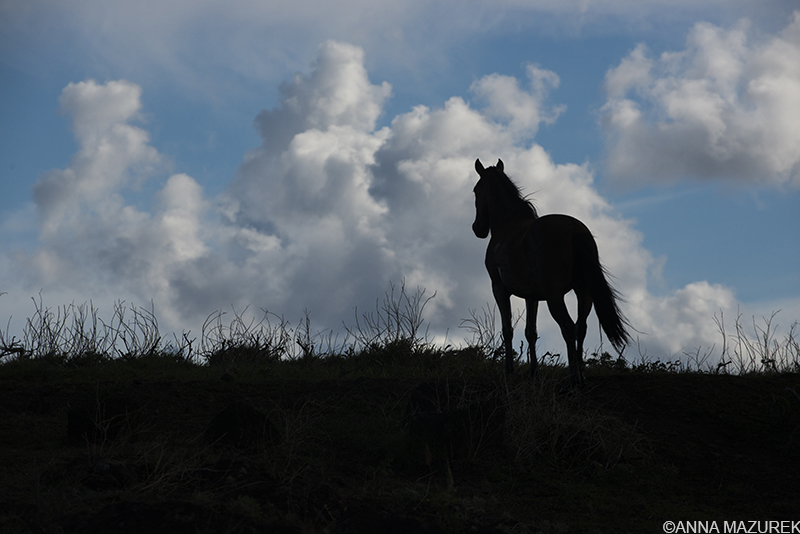
The wild horses were the biggest surprise about Easter Island for me. While many of the horses are branded, they roam free and often hang out in the roads. Be careful when driving.
Seven-Day Trip to Easter Island Costs
Groceries: 49.18
Beer: $5.41
Gas: $22.16
Rental Car for 3 days: $173.35
National Park Ticket: $80
North Coast Hike: $82.08
Accommodation: $123.89
Total Cost: $553.23
This does NOT include my flight, which cost $887 from Santiago roundtrip. (I bought the flight with the miles on my Chase Sapphire Card, which is currently the best rewards card on the market.) Flights range from $400-$1200 roundtrip. I booked my flight six months in advance.
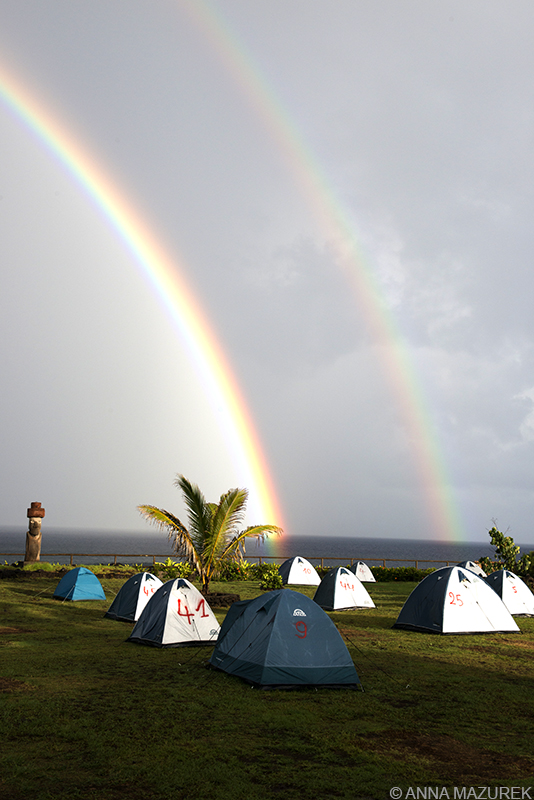
After a heavy rainstorm one morning, these double rainbows appeared at Camping Mihinoa, our accommodation. While we stayed in a room inside one of the buildings, many people rented tents and camped.
Budget Tips for Easter Island
- Book your flight 6-9 months in advance. Flights can be as low as $400 roundtrip from Santiago nine-months in advance! LATAM is the only airline with service to Easter Island. There are eight flights a week from Santiago and one flight on Monday nights that continues to Tahiti. It’s the nicest airline in South America.
- Camp or book budget accommodation. My friend and I stayed at Camping Mihinoa and rented a private room with two beds with a shared bathroom for $40 USD/night. That’s $20/each, which is the cost of most hostels in mainland Chile. They also offer tents and dorms for cheaper rates – usually $15/person. The place was spotless and had a good location.
- Trip Length. Four to five days is sufficient to see the island. Flights just worked out cheaper for us to stay longer, which is why we stayed six nights.
- Cook. Food is insanely expensive! This partly due to the remoteness of the island and lack of resources. We cooked the entire trip except for a small meal out when we arrived. Fish and chips at a restaurant was $30 USD! Beer was $6 at the grocery store!
- Take food with you. I saw people check bags of food on the flight. There isn’t much variety of food on the island or in the grocery stores so if you are on a budget, pack what you can!
- Take USD. Sometimes, it’s cheaper to have USD with you. For example, I saved $9 paying in USD for the Easter Island park entry fee in USD.
- Check the exchange rate. Many things are listed in both USD and Chilean Pesos. I use the free XE app to check prices to see which currency is the best deal. I saved $54 paying for my six-night accommodation on the island in pesos.
- Rent Your Own Car. If you can drive a manual transmission car and have a group of people, it’s significantly cheaper to explore the island on your own. Plus, you’ll get better photos since the tours are always during the worst time of the day for photos. It’s $60/day for a manual transmission car and $100/day for an automatic transmission. Day tours start at $120 USD/person! Gas isn’t cheap so keep that in mind. I still think the flexibility is worth the price of renting a car.
- Expect Bad Wifi. Accept the fact that you are in the middle of the Pacific Ocean. Wifi is painfully slow.

